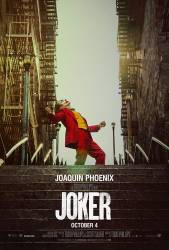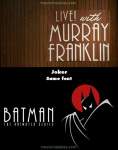Factual error: Based on the films being shown at the theater, the movie appears to be set in 1981. One of the TV commercials shows the Energizer Bunny, which didn't make its first appearance until 1988.
Continuity mistake: When Joker is dancing on the stairs he throws his cigarette. Then when the cops arrive at the top of the stairs we see him blowing smoke from the same cigarette. Then the cigarette is gone again. (01:30:40)
Factual error: In the beginning of the movie, while dancing with the sign, the guitars in the window of the music store are D'Angelico guitar designs that weren't released until the 2010s. (00:01:35)
Factual error: The cart behind Arthur during his dance for the kids has drawers of different colors. That is color coding reflecting the Broselow Tape, a tool used to measure pediatric patients and give estimates of the appropriate scaling for treatments. It's a system that started only in 1985, while the movie takes place in 1981. (00:28:05)
Factual error: In the elevator, Arthur meets the single mom living on the same floor, Sophie Dumond. In Sophie's shopping bag, the one recognizable food item is a box of Betty Crocker's Hamburger Helper - Potato Stroganoff. Thing is, the packaging uses (look at the design of the 'menu idea') a design predating the introduction of the Helping Hand mascot, which happened in the late 70s. She just bought it, it can't be ancient, long expired food. (00:19:35)
Factual error: When Joker is following his neighbor to her work, the 'no standing' sign is not from the time period. Also when Joker is fleeing from two police officers into the subway at 18 avenue, the subway sign with the red EXIT background is not of the time period.
Continuity mistake: Right at the beginning of the dance in the children ward, the kid with a blue hat on Arthur's right is sitting cross-legged with the hospital robe covering his calves and feet. At the first cut, his jammies and socks become visible. (00:28:05)
Revealing mistake: The sign with "everything must go" breaks a second before it hits Arthur. (00:02:55)
Suggested correction: The sign with "everything must go" breaks at the exact same second as it hits Arthur, and there is no point to make it somehow break by some weird special effect without any sense.
Plot hole: Arthur's appearance on the talk show makes hardly any sense. The show is a close port of Johnny Carson's Tonight show, for a huge audience, and yet he receives no screening at all, they put him (someone NOBODY in the staff knows the first thing about) on the air literally without a clue of what he is gonna do or say, and wearing a highly controversial costume. And, when he murders Murray, it is implied that everyone was able to see him doing that right away and he is cut 'off the air' at some point, as if the show were really live, which is preposterous for this sort of program outside of specific events (similar to how in contemporary TV "Jimmy Kimmel Live!", is not live). Even earlier when Arthur opened the letter his mom addressed to Wayne, you could hear the end credits of "Live with Murray Franklin" with the announcer saying the show is "Taped live in front of a studio audience." (00:48:00)
Suggested correction: I don't see this is a problem due to the fact that we can't be sure what really happens as apposed to what only happens in Arthur's mind. So if the whole TV show appearance is just another fantasy, he would have skipped the who screening process.
You are free to treat the whole movie as something where things don't make sense because in the fan theory of your liking it's all meant to have subtle hints that the movie is all a fantasy, but the movie does not present that particular talk show scene as a dream sequence. It'd be silly to nitpick the logic in the scene when he is picked from the audience by Murray at the beginning because it's obviously presented as nothing more than his fantasy, but his appearance on the show is what the movie built up to up to that point and is not treated as a parenthesis where logic should be suspended, nor disproven like the scenes with his girlfriend standing in.
Suggested correction: The points raised are logical in the context of our real world. However, in the film world, different rules/logic can apply, and apparently do. In the movie world, this show is live, etc. Saying that something is taped live doesn't mean that it isn't also broadcast live; the two don't have to be mutually exclusive. They could just be saying that so people don't think they use a laughter track.
Continuity mistake: Murray's blue jacket, when he comes out from behind the curtain his jacket is open, than he makes a twirl and the first button of the jacket is buttoned up.
Factual error: Following Zazie Beetz, Arthur arrives in front of the bank. The crossing is using red colored tactile paving. While technically already invented, truncated domes paving was not adopted in the US in the early 80s, but began appearing in the early 1990s at public transportation stations, and it was not until 2001 that they were used in curb cuts. (00:24:35)
Suggested correction: By the directors own admission, the date the movie is set in is never mentioned, nor is there any mention of a real city it is set in. This movie is set in Gotham City, a city that exists only in the Joker universe, where this paving could have been invented years earlier than the corresponding year in our (real) universe. This is more of a trivia than a mistake.
By the director's own movie, everything about the setting is specific to the early 80s. It's a marginal part of the urban scenery that they didn't find important (or did not think of, it's not exactly obvious) to fix for consistency. I don't see why we have to think that a movie that deliberately puts real life advertising, technology, aesthetics specific to the 1980s (Philips even mentioned specifically in interviews that he had in mind New York City of the year 1981) and flaunts the marginalization and cruelty of society would encourage leaving in deliberately something that improves quality of life for the handicapped. It's the classic mistake of something not supposed to be there that needed to be covered but was not.
Factual error: The ambulance that crashes into the police car Joker is riding in towards the end of movie has the styling of a contemporary vehicle, not one from the early 1980s.
Other mistake: In a city of millions and millions of inhabitants, when the protagonist chases his neighbour till she enters the building in William Street, the taxi that passes in front of him as he crosses the road is the same taxi with license plate T 9362 that nearly ran him over at the very beginning when he was trying to get his sign back. Which incidentally is a model of Chevy Caprice post-1981 (likely a 1987 Caprice). (00:02:25 - 00:24:35)
Audio problem: The police officers chase Arthur to the subway. When the subway train starts moving after they just barely got in, the sound resembles the acceleration sound of a R143 subway car, which actually didn't exist until 2001, but it's a much older car, the R32.
Continuity mistake: When Joker is in the police car, the left eye paint flows across the corner of his mouth. Then the car crashes, people pull him out of the car, and the paint just reaches his nose. Then he stands up and the previous style is back. (01:46:50 - 01:50:10)
Factual error: The Waynes went to a theater with 5 movies, with the main spot being Blow Out and Zorro the Gay Blade, who came out on July 24th and 17th of the year. You can also see marquees for other July movies; Wolfen, on the 24th, Arthur, on the 17th. But the narration that opens the movie said it was Thursday October 15, and the events of the movie span across at the very least two weeks (the Joker gets booked on Murray's for "next Thursday" when at least a week has passed since the intro). So the theater is showing in November movies that are over 3 months old (7 for 'Excalibur'. Last movie to be featured) and no new releases. (01:49:10)
Suggested correction: Yep. No fact is in error here. It's not a fact that states this isn't possible.
Especially since that's what discount theatres did (sometimes called dollar theatres): showed 2nd run films months after they were initially released.
Other mistake: Arthur watches Murray's show in the hospital room, he is able to see himself in the Pogo's Comedy Club performance. Forgetting how very contemporary this whole "viral video of person making a fool out of himself" dynamic is, and how astronomically unlikely it is that there would be taping of some open mike session in a club, it still makes in fact sense that there could be a recording of Arthur's performance, since there is a monitor backstage and in an earlier scene there was a guy with a camera on a tripod far in the back of the room when Arthur was taking notes. But in the video shown during Murray's opening there are 2 different angles of the performance, which are also different from the one show in the monitor backstage. Amateur night with 3 cameramen and a director/editor? Come on. (00:59:50)
Factual error: When Joaquin Phoenix and Zazie Beetz are taking a walk after Arthur's performance, between the arcade and the newsstand there's a modern video intercom with keypad, not quite fitting the 1981 setting, since the first model of its kind was introduced in 1984 (kinda odd to leave something like this in when they went through the trouble of placing appropriate arcade posters really close by). (00:45:25)
Continuity mistake: When Arthur imagines that he is on Franklin's TV show the button on Murray's jacket is off then on. (00:12:20)
Continuity mistake: During the first part of the interview, Murray Franklin's hands keep changing position inconsistently holding cue cards or being flat on the desk. (01:39:25)







Suggested correction: They purposely stuck the images in a way that it repeats itself over and over again. It's intentionally made in a way of not flowing straightforward.